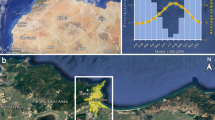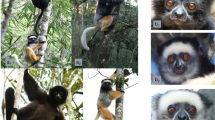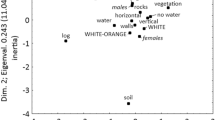Abstract
Urbanization is a major challenge for biodiversity conservation, yet the evolutionary processes taking place in urbanized areas remain poorly known. Human activities in cities set new selective forces in motion which need to be investigated to predict the evolutionary responses of animal species living in urban areas. In this study, we investigated the role of urbanization and parasites in the maintenance of melanin-based color polymorphism in the feral pigeon Columba livia. Using a correlative approach, we tested whether differently colored genotypes displayed alternative phenotypic responses to urbanization, by comparing body condition, blood parasite prevalence and parasite load between colored morphs along an urbanization gradient. Body condition did not vary with urbanization, but paler individuals had a higher body condition than darker individuals. Moreover, paler morphs were less often parasitized than darker morphs in moderately urbanized habitats, but their parasite prevalence increased with urbanization. In contrast, darker morphs had similar parasite prevalence along the urbanization gradient. This suggests that paler morphs did better than darker morphs in moderately urbanized environments but were negatively affected by increasing urbanization, while darker morphs performed equally in all environments. Thus, differently colored individuals were distributed non-randomly across the urban habitat and suffered different parasite risk according to their location (a gene-by-environment interaction). This suggests that melanin-based coloration might reflect alternative strategies to cope with urbanization via different exposure or susceptibility to parasites. Spatial variability of parasite pressures linked with urbanization may, thus, play a central role in the maintenance of plumage color polymorphism in this urban species.


Similar content being viewed by others
References
Aiken L, West S (1991) Multiple regressions: testing and interpreting interactions. Sage, Thousand Oaks
Almasi B, Jenni L, Jenni-Eiermann S, Roulin A (2010) Regulation of stress response is heritable and functionally linked to melanin-based coloration. J Evol Biol 23:987–996
Atwell JW, Cardoso GC, Whittaker DJ, Campbell-Nelson S, Robertson KW, Ketterson ED (2012) Boldness behavior and stress physiology in a novel urban environment suggest rapid correlated evolutionary adaptation. Behav Ecol. doi:10.1093/beheco/ars059
Bradley CA, Altizer S (2007) Urbanization and the ecology of wildlife diseases. Trends Ecol Evol 22:95–102
Burnham KP, Anderson DR (2002) Model selection and multimodel inference: a practical information-theoretic approach. Springer, New York
Bόkony V, Seress G, Nagy S, Lendvai AZ, Liker A (2012) Multiple indices of body condition reveal no negative effect of urbanization in adult house sparrows. Landsc Urban Plan 104:75–84
Cadenasso L, Pickett S, Schwarz K (2007) Spatial heterogeneity in urban ecosystems. Reconceptualizing land cover and a framework for classification. Front Ecol Env 5:80–88
Calsbeek B, Hasselquist D, Clobert J (2010) Multivariate phenotypes and the potential for alternative phenotypic optima in wall lizard (Podarcis muralis) ventral color morphs. J Evol Biol 23:1138–1147
Clark P, Boardman W, Raidal S (2009) Atlas of clinical avian hematology. Wiley-Blackwell, Chichester
Contassot Y (2007) La politique de la ville: pour une gestion durable des pigeons à Paris. Bien vivre avec les animaux à Paris, le guide de l’animal en ville. Mairie de Paris, Paris
Crane P, Kinzig A (2005) Nature in the metropolis. Science 308:1225
Delgado CA, French K (2012) Parasite-bird interactions in urban areas: current evidence and emerging questions. Landsc Urban Plan 105:5–14
Ducrest AL, Keller L, Roulin A (2008) Pleiotropy in the melanocortin system, coloration and behavioural syndromes. Trends Ecol Evol 23:502–510
Evans KL (2010) Individual species and urbanization. In: Gaston KJ (ed) Urban ecology. Cambridge University Press, Cambridge, pp 53–87
Evans KL, Gaston K, Sharp S, McGowan A, Simeoni M, Hatchwell BJ (2009) Effects of urbanization on disease prevalence and age structure in blackbird Turdus merula populations. Oikos 118:774–782
Fallon SM, Ricklefs RE (2008) Parasitemia in PCR-detected Plasmodium and Haemoproteus infections in birds. J Avian Biol 39:514–522
Farnsworth ML, Wolfe LL, Hobbs NT, Burnham KP, Willimas ES, Theobald DM, Conner MM, Miller MW (2005) Human land use influences chronic wasting disease prevalence in mule deer. Ecol Appl 15:119–126
Fokidis HB, Greiner EC, Deviche P (2008) Interspecific variation in avian blood parasites and haematology associated with urbanization in a desert habitat. J Avian Biol 39:300–310
Frantz A, Pottier MA, Karimi B, Corbel H, Aubry E, Haussy C, Gasparini J, Castrec-Rouelle M (2012) Contrasting levels of heavy metals in the feathers of urban pigeons from close habitats suggest limited movements at a restricted scale. Environ Pollut 168:23–28
Gasparini J, Erin N, Bertin C, Jacquin L, Vorimore F, Frantz A, Lemouvel P, Laroucau K (2011) Impact of urban environment and host phenotype on the epidemiology of Chlamydiaceae in feral pigeons (Columba livia). Environ Microbiol 13:3186–3193
Gillespie JH, Turelli M (1989) Genotype-by-environment interactions and the maintenance of polygenic variations. Genetics 114:333–343
Grégoire A et al (2002) A comparison of infestation patterns by Ixodes ticks in urban and rural populations of the common blackbirds Turdus merula. Ibis 144:640–645
Grueber CE, Nakagawa S, Laws RJ, Jamieson IG (2011) Multimodel inference in ecology and evolution: challenges and solutions. J Evol Biol 24:699–711
Haag-Wackernagel D (1995) Regulation of the street pigeon in Basel. Wildl Soc Bull 23:256–260
Haag-Wackernagel D, Heeb P, Leiss A (2006) Phenotype-dependent selection of juvenile urban feral pigeons Columba livia. Bird Study 53:153–170
Haase E, Ito S, Sell A, Wakamatsu K (1992) Melanin concentrations in feathers from wild and domestic pigeons. J Hered 83:64–67
Hake M (1996) Fattening strategies in dominance-structured greenfinch flocks in winter. Behav Ecol Sociobiol 39:71–76
Hart BL (1997) Behavioural defence. In: Clayton DH, Moore J (eds) Host-parasite evolution: general principle and avian models. Oxford University Press, Oxford
Hawkey CM, Dennet TB (1989) A colour atlas of comparative veterinary haematology. Wolfe, London
Hoekstra HE, Krentz JG, Nachman NW (2005) Local adaptation in the rock pocket mouse Chaetodipus intermedius: natural selection and phylogenetic history of populations. Heredity 94:217–228
Hõrak P, Vellau Ots I, Moller AP (2008) Growth conditions affect carotenoid-based plumage coloration of great tit nestlings. Naturwissenschaften 87:460–464
Hubbard JK, Uy JA, Hauber M, Hoekstra H, Safran R (2010) Vertebrate pigmentation: from underlying genes to adaptive function. Tr Genet 26(231):239
Jacquin L 2011 Coloration mélanique et stratégies d’histoire de vie chez le pigeon biset urbain. PhD thesis, Université Pierre et Marie Curie, Paris
Jacquin L, Cazelles B, Julliard AC, Leboucher G, Gasparini J (2010) Reproduction management affects breeding ecology and reproduction costs in urban feral pigeons Columba livia. Can J Zool 88:781–787
Jacquin L, Lenouvel P, Haussy C, Ducatez S, Gasparini J (2011) Melanin-based coloration is related to parasite intensity and cellular immune response in an urban free living bird: the feral pigeon. J Avian Biol 42:11–15
Jacquin L, Récapet C, Bouche P, Leboucher G, Gasparini J (2012) Melanin-based coloration reflects alternative strategies to cope with food limitation in feral pigeons. Behav Ecol 23:907–915
Jacquin L, Haussy C, Bertin C, Laroucau K, Gasparini J (2013) Darker females transmit more specific antibodies to their eggs than paler ones in feral pigeons. J Linn Soc 108:647–657
Johnson SL (2010) Relationship between feral pigeon (Columba livia) plumage morphs and urban habitat types in greater Manchester. MSc report, University of Salford, Manchester
Johnson SG, Johnston RF (1989) A multifactorial study of variation in inter clutch interval and annual reproductive success in the feral pigeon, Columba livia. Oecologia 80:87–92
Johnston RF, Janiga M (1995) Feral pigeons. Oxford University Press, Oxford
Karell P, Ahola K, Karstinen T, Kolunen H, Siitari H, Brommer JE (2011) Blood parasites mediate morph-specific maintenance costs in a colour polymorphic wild bird. J Evol Biol 24:1783–1792
Kautz JR, Seamans TW (1986) Estimating age of nestling and juvenile feral rock doves. J Wildl Manage 50:544–547
Kawecki TJ, Ebert D (2004) Conceptual issues in local adaptation. Ecol Lett 7:1225–1241
Lehtonen PK, Laaksonen T, Artemyev A, Belksii E et al (2009) Geographic patterns of genetic differentiation and plumage color variation are different in the pied flycatcher. Mol Ecol 18:4463–4476
Leiss A, Haag-Wackernagel D (1999) Variability and determination of the plumage coloration of the feral pigeon Columba livia. Ecol Birds 21:331–363
Liker A, Pape Z, Bokoni V, Landvai AZ (2008) Lean birds in the city: body size and condition of house sparrows along the urbanization gradient. J Anim Ecol 77:789–795
Majerus MEN (1998) Melanism: evolution in action. Oxford, Oxford
McKinney ML (2002) Urbanization, biodiversity, and conservation. Bioscience 52:883–890
McKinnon JS, Pierotti ME (2010) Colour polymorphism and correlated characters: genetic mechanisms and evolution. Mol Ecol 19:511–5125
Møller AP (2008) Flight distance of urban birds, predation, and selection for urban life. Behav Ecol Sociobiol 63:63–75
Møller AP (2009) Successful city dwellers: a comparative study of the ecological characteristics of urban birds in the Western Paleartic. Oecologia 159:849–858
Monros JS, Belda EJ, Barba E (2002) Post-fledging survival of individual great tits: the effects of hatching date and fledging mass. Oikos 99:481–488
Moreno J, Møller AP (2006) Are melanin ornaments signals of antioxidant and immune capacity in birds? Acta Zool Sin 52:202–208
Obukhova NY (2011) Dynamics of balanced polymorphism morphs in Blue Rock Pigeon Columbia livia. Russ J Genet 47:83–89
Partecke J, van’t Hof T, Gwinner E (2004) Differences in the timing of reproduction between urban and forest European blackbirds (Turdus merula): result of phenotypic flexibility or genetic differences? Proc R Soc Lond B 271:1995–2001
Peig J, Green AJ (2009) New perspectives for estimating body condition from mass/length data: the scaled mass index as an alternative method. Oikos 118:1883–1891
Peig J, Green AJ (2010) The paradigm of body condition: a critical reappraisal of current methods based on mass and length. Funct Ecol 24:1323–1332
Piault R, Gasparini J, Bize P, Jenni-Eiermann S, Roulin A (2009) Pheomelanin-based coloration and the ability to cope with variation in food supply and parasitism. Am Nat 174:548–556
Pickett ST, Burch W, Dalton S, Grive JM, Rowntree R (1997) A conceptual framework for the study of human ecosystems. Urban Ecosyst 1:185–199
Reyer HU, Fischer W, Steck P, Nabulon T, Kessler P (1998) Sex-specific nest defense in house sparrows (Passer domesticus) varies with badge size of males. Behav Ecol Sociobiol 42:93–99
Rose E, Nagel P, Haag-Wackernagel D (2006) Spatio-temporal use of the urban habitat by feral pigeons (Columba livia). Behav Ecol Sociobiol 60:242–254
Roulin A (2004) The evolution, maintenance and adaptive significance of genetic colour polymorphism. Biol Rev 79:815–848
Roulin A, Ducrest A-L (2011) Association between melanism, physiology and behavior: a role for the melanocortin system. Eur J Pharmacol 660:226–233
Roulin A, Riols C, Dijkstra C, Ducrest AL (2001) Female plumage spottiness and parasite resistance in the barn owl Tyto alba. Behav Ecol 12:103–110
Sánchez-Guillén RA, Martínez-Zamilpa SM, Jiménez-Cortés JG, Forbes MR, Córdoba-Aguilar A (2013) Maintenance of polymorphic females: do parasites play a role? Oecologia 171:105–113
Senar JC (2006) Bird colors as intrasexual signals of aggression and dominance. In: Hill GE, McGraw KJ (eds) Bird coloration. II. Harvard University Press, Cambridge
Shochat E (2004) Credit or debit? Resource input changes population dynamics of city-slicker birds. Oikos 106:622–626
Shochat E, Warren P, Faeth S, McIntyre N, Hope D (2006) From patterns to emerging processes in mechanistic urban ecology. Trends Ecol Evol 21:186–191
Sirkiä PM, Virolainen M, Laaksonen T (2010) Melanin has temperature-dependent effects on breeding performance that may maintain phenotypic variation in a passerine bird. J Evol Biol 23:2385–2396
Sol D, Senar JC (1995) Urban pigeon populations: stability, home range, and the effect of removing individuals. Can J Zool 73:1154–1160
Sol D, Santos D, Garcia J, Cuadrado M (1998) Competition for food in urban pigeons, the cost of being juvenile. Condor 100:298–304
Sol D, Jovani R, Torres J (2000) Geographical variation in blood parasites in feral pigeons: the role of vectors. Ecography 23:307–314
Wolf BO, Walsberg GE (2000) The role of the plumage in heat transfer processes of birds. Am Zool 40:575–584
Wright A, Gompper ME (2005) Altered parasite assemblage in raccoons in response to manipulated resource availability. Oecologia 144:148–156
Yeh PJ (2004) Rapid evolution of a sexually selected trait following population establishment in a novel habitat. Evolution 58:166–174
Acknowledgments
This paper is dedicated to the late Aurore Boussier. All experiments and protocols were approved and authorized by the veterinary department of Seine-et-Marne (authorization no. 77-05). We are grateful to T. Charachon, the Mairie de Paris, the AERHO association, the ESPACES association, M. Toresila and the SACPA company for logistic support during the captures. We thank S. Ollier for help with statistical analyses and A. Belguermi, A. Cuquemelle, S. Loisel, L. Chauvin, C. Haussy and F. Tisseront for great help at different stages of this study. We thank two anonymous referees and S. Reader for helpful comments on a previous version of the manuscript. This work was supported by grants from the Region Ile-de-France (Sustainable Development Network R2DS, no. 2008-07) and the IFR 101 Ecology, Biodiversity, Evolution, Environment. L. Jacquin was supported by the French Ministry of Research and the Fyssen Foundation.
Author information
Authors and Affiliations
Corresponding author
Additional information
Communicated by Markku Orell.
Rights and permissions
About this article
Cite this article
Jacquin, L., Récapet, C., Prévot-Julliard, AC. et al. A potential role for parasites in the maintenance of color polymorphism in urban birds. Oecologia 173, 1089–1099 (2013). https://doi.org/10.1007/s00442-013-2663-2
Received:
Accepted:
Published:
Issue Date:
DOI: https://doi.org/10.1007/s00442-013-2663-2




